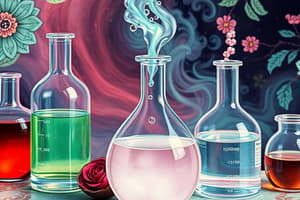Podcast
Questions and Answers
Which functional group is classified as electron-donating?
Which functional group is classified as electron-donating?
- Ether (-O-)
- Aldehyde (-CHO)
- Amino (-NH2) (correct)
- Carboxyl (-COOH)
What is the general formula for alkanes?
What is the general formula for alkanes?
- CnH2n
- CnH2n+1
- CnH2n+2 (correct)
- CnH2n-1
What is the primary reason why alkenes are more reactive than alkanes?
What is the primary reason why alkenes are more reactive than alkanes?
- The presence of a triple bond
- The presence of a double bond (correct)
- The presence of a stereocenter
- The presence of a functional group
What is the term for the three-dimensional arrangement of atoms in molecules?
What is the term for the three-dimensional arrangement of atoms in molecules?
What type of synthetic reaction involves the removal of a functional group to form a new bond?
What type of synthetic reaction involves the removal of a functional group to form a new bond?
Which of the following is an example of a nucleophilic reaction?
Which of the following is an example of a nucleophilic reaction?
What is the term for a chiral molecule that cannot be superimposed on its mirror image?
What is the term for a chiral molecule that cannot be superimposed on its mirror image?
What is the primary function of a functional group in a molecule?
What is the primary function of a functional group in a molecule?
Which type of reaction involves the replacement of a functional group with another?
Which type of reaction involves the replacement of a functional group with another?
What is the general term for the study of the three-dimensional arrangement of atoms in molecules?
What is the general term for the study of the three-dimensional arrangement of atoms in molecules?
Flashcards are hidden until you start studying
Study Notes
Functional Groups
- A functional group is a specific group of atoms within a molecule that determines its chemical properties and reactivity
- Common functional groups:
- Hydroxyl (-OH)
- Carboxyl (-COOH)
- Amino (-NH2)
- Aldehyde (-CHO)
- Ketone (-CO-)
- Ester (-COO-)
- Ether (-O-)
- Functional groups can be classified as:
- Hydrophilic (water-loving) or hydrophobic (water-fearing)
- Acidic or basic
- Electron-withdrawing or electron-donating
Alkanes
- Alkanes are saturated hydrocarbons with the general formula CnH2n+2
- They are non-polar and non-reactive
- Physical properties:
- Boiling points increase with increasing molecular weight
- Melting points increase with increasing molecular weight
- Density increases with increasing molecular weight
- Chemical properties:
- Alkanes are resistant to oxidation and reduction
- They undergo combustion reactions with oxygen
- They can undergo substitution reactions with halogens
Alkenes
- Alkenes are unsaturated hydrocarbons with one or more carbon-carbon double bonds
- They are more reactive than alkanes due to the presence of the double bond
- Physical properties:
- Boiling points are generally lower than those of alkanes
- Melting points are generally lower than those of alkanes
- Density is generally lower than that of alkanes
- Chemical properties:
- Alkenes undergo addition reactions with electrophiles
- They can undergo polymerization reactions
- They can undergo oxidation reactions
Stereochemistry
- Stereochemistry is the study of the three-dimensional arrangement of atoms in molecules
- Stereoisomers:
- Enantiomers: non-superimposable mirror images
- Diastereomers: non-superimposable non-mirror images
- Chirality:
- A chiral molecule is one that cannot be superimposed on its mirror image
- Chiral molecules can rotate plane-polarized light
- Stereocenters:
- A stereocenter is an atom that has a non-superimposable arrangement of atoms bonded to it
- Stereocenters can be asymmetric or symmetric
Synthetic Reactions
- Synthetic reactions are reactions used to form new molecules
- Types of synthetic reactions:
- Substitution reactions: replacement of a functional group with another
- Elimination reactions: removal of a functional group to form a new bond
- Addition reactions: formation of a new bond by adding a functional group
- Rearrangement reactions: reorganization of a molecule's structure
- Synthetic reactions can be classified as:
- Electrophilic reactions: involve the attack of an electrophile (electron-deficient species)
- Nucleophilic reactions: involve the attack of a nucleophile (electron-rich species)
Nomenclature
- Nomenclature is the system of naming organic compounds
- IUPAC (International Union of Pure and Applied Chemistry) rules:
- Identify the parent chain (longest continuous chain)
- Identify the functional groups and their locations
- Assign a prefix and suffix to the parent chain
- Use Greek letters to indicate the location of substituents
- Common prefixes:
- Meth- (one carbon)
- Eth- (two carbons)
- Prop- (three carbons)
- But- (four carbons)
- Common suffixes:
- -ane (alkane)
- -ene (alkene)
- -ol (alcohol)
- -al (aldehyde)
- -one (ketone)
Studying That Suits You
Use AI to generate personalized quizzes and flashcards to suit your learning preferences.




